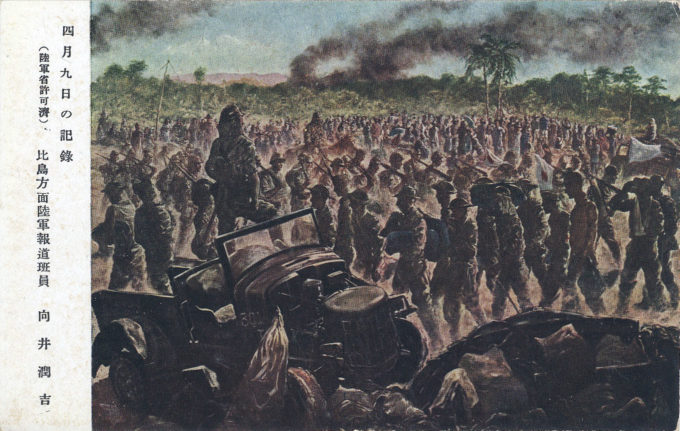
Jpaanese propaganda postcard illustrating the surrender of the US & Philippine armies at Bataan, Philippines, on April 9, 1942. Until Bataan surrendered, most Americans had chosen to ignore the hopelessness of the army’s position in the Philippines. But, as Japanese forces advanced across the Pacific and Southeast Asia, and as one British colony fell after another, public attention focused increasingly on the fighting in the Philippines – if only because it hadn’t ended yet.
See also:
Attack on Pearl Harbor propaganda postcard, c. 1942.
The Japanese Occupation of Singapore, c. 1942.
“Compared to some of its neighbors, the Philippines, an American possession since 1898, was a bit of a backwater. None of Singapore’s sparkle or the hustle of Hong Kong, but the guidebooks of the day called the place ‘paradise’, and the books were right. Manila was beautiful, palms leaning gently over the seawall along the bay, the night filled with the sweet scent of kamias.
“On December 8, eight hours after it attacked the American Pacific Fleet at Pearl Harbor, Japan sent its bombers and fighters against American air, infantry, and naval bases in the Philippines. Two weeks later, 43,000 Japanese troops invaded the islands.
“Waiting for them was a large force of American and Filipino defenders, more than 130,000 men, untried and ill trained, most of them. The Japanese pushed them back and back again until they were forced to retreat to a small thumb of land on the west coast of Manila Bay, then peninsula of Bataan.
“… Starting in January 1942, the Japanese took the peninsula under siege and left the Americans and Filipinos cut off from all help and supplies. The two sides fought for ninety-nine days, the Japanese taking horrendous casualties, the Americans and Filipinos falling back under the Japanese assaults from one ‘final’ defense line to another. At last, on April 9, sick and starving, without an air force to protect them or navy to relieve them, the men of Bataan surrendered.
“More than 79,000 Americans and Filipinos under American command laid down their arms – the single largest defeat in American military history. The sick, starving, and bedraggled prisoners of war were rounded up by the Japanese captors and made to walk sixty-six miles to a railhead for the trip to prison camp, a baneful walk under a broiling sun that turned into one of the most notorious treks in the annals of war, the Bataan Death March.”
– Tears in the Darkness, by Michael Norman and Elizabeth M. Norman, 2009

